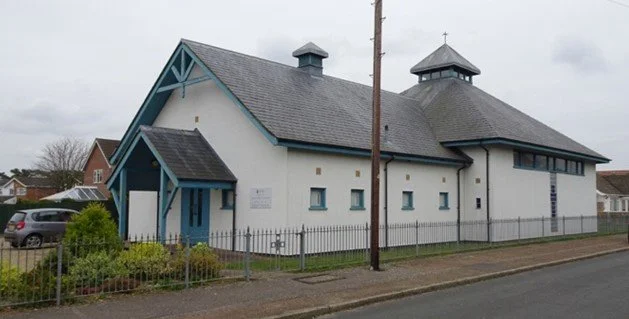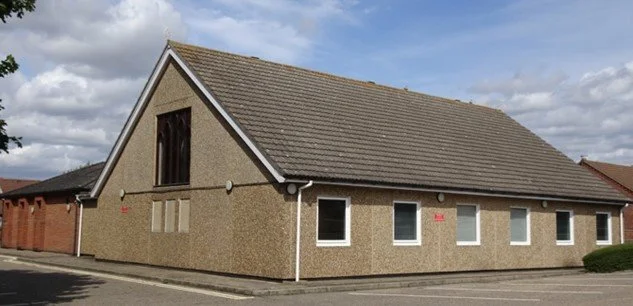St John’s parish and our parish of St Georges’ came into existence to serve Catholics in this area in the 1890s. While St John’s was centred on the new, magnificent and largest parish church in the country, St Georges was centred on the beautiful old building in Fishergate Street. A building originating in the 1600’s to meet the requirements of Thomas Anguish’s will to provide accommodation for poor boys and later girls from Norwich. The premises devised by Thomas Anguish but rebuilt and added to over the centuries were used for many years as the Boys Hospital ‘for the purpose of keeping, bringing up and teaching of young and very poor children born in the City of Norwich until a Hospital or convenient place for this purpose could be erected, when the said premises could be let and the rents and profits thereof should go towards the maintenance of such poor children brought up therin.” [part of the Charity Commissioners report dated 1833-1836.] It was this building that the Northampton Diocese bought and converted into a church (the funds for this were provided by the late Earl of Orford and by the Duke of Norfolk).for the Parish Church of St George, Fishergate in 1897 with the first priest being Fr. H Long.
In 1896, not long after the church (later cathedral) of St John the Baptist was opened for worship, a partly seventeenth century former Boy’s Hospital and school was bought in Fishergate (then a densely populated part of Norwich) for Catholics in the northern part of the city. It was dedicated to St George. St John the Baptist replaced the chapel of St John in Maddermarket and many of the latter’s furnishings came to Fishergate and vestments came from Costessey Hall chapel. (The home of the Jerningham Family). The church was initially served by St John’s until the Revd Henry Long took up residence nearby in 1897, and a mission was established in 1899. Slum clearance in the city meant huge new council estates (such as Mile Cross) came to be built in the 1920s and 30s and the working population of the parish moved further north and, after World War Two, northeast to Heartsease and east to Thorpe. Masses were said in various locations in these areas, (including the Norman Centre and the Heartsease Pub).
St. Boniface
In January 1949, the Revd Kevin Jones of St George, Fishergate, Norwich was told that an Air Ministry gymnasium and chapel near the Horsham St Faith airfield (three miles north of the city) had come on to the market. He probably knew of it from his work with the airmen (especially Americans) during the war. By March he had obtained planning permission for use of the site for religious purposes, and it was purchased for £2,000 on a 25-year lease.
It replaced a Mass centre at Norman School, Mile Cross. The building, substantially constructed of concrete was designed as a gymnasium for the St Faith’s airfield, but owing, it was stated, to an error it was mistakenly sited in Brabazon Road and after the War was discarded as being too far from the station. During the time of the Revd Philip Shryane (1990-2000) the building was found to be full of asbestos and had to be replaced rather than repaired. With fundraising and especially by selling some of the surrounding land for two houses, it was replaced by the present structure, designed by Feilden & Mawson of Norwich and opened by Bishop Peter Smith on 5 June 2001.
Our Lady Mother of God
The northeast of Norwich expanded rapidly after World War II, and St William’s Way was built as a northern arterial road. By the late 1960s, clergy at Saint George’s were saying Mass in a school for the growing number of Catholics living in this part of the parish. A Development Fund was established and the priest negotiated to buy a site sufficient for a church and junior school on Saint Williams Way.
The local authority (then Blofield and Flegg Rural District Council) had concerns for the quality of the new building and that the car park would look untidy from St William’s Way. Planning permission was finally given in 1970, with strict conditions about landscaping that cost the parish £7,000 on top of the construction cost of £17,000. On 8 February 1972 the Rt Revd Alan Clark, Bishop of Elmham, blessed the church and dedicated it to Our Lady Mother of God. The Eastern Daily Press report described the building as ‘simple, straightforward and adequate’. It is believed to have been erected under the direction of a parishioner, and no architect has been identified.
A red brick parish hall, with almost as big a footprint as the church, was added at right angles to the church in about 1980. Its main entrance was opposite the door to the church so they shared the porch and the new WC block and large kitchen.
St. George’s
By 1958, Fishergate had become much too small and after investigating the possibility of redeveloping the site or taking over the nearby redundant medieval church of St Simon and St Jude, Sprowston was confirmed as the parish’s priority in 1960 and the architect Sebastian Comper approached. He was Bishop Leo Parker’s favoured architect, and his first sketches appeared in September 1960. Although supported by the Bishop’s Committee, the local authority planners would not accept them. After further negotiations, planning permission was given in September 1961. The Norwich builder R.G. Carter Ltd was awarded the contract for £47,575 in June 1962 and work started soon afterwards, volunteers having done much site clearance.
Almost immediately engineers had to be engaged, as there seemed to be no bottom to the subsoil, which was not too surprising as it had been a lime quarry filled with rubbish. Piling for the east end reached 89 ft, at the west 60 ft. In the end, 91 piles were driven, at an additional cost of £9,000.
On 22 December 1962, Bishop Parker of Northampton laid the foundation stone at the east end of the north nave aisle, returning to celebrate Solemn High Mass and bless the church on 18 March 1964. By the autumn, a cedar wood parish hall had been built to the south of the church. The total cost of the church was £76,500 and the hall £6,000. Remarkably, the whole debt was cleared by mid-1966, a substantial contribution coming from the popular ‘Turniptop’ fundraising scheme. The church was consecrated by Bishop Parker on 24 May 1966. Ironically, Bishop Parker had only recently returned from the Second Vatican Council, and St George’s showed no sign of the reforms the Council wanted. The altar was brought forward in 1970 but it was the Revd Tony Rogers who created today’s sanctuary in 1986, replacing the original altar, removing the suspended canopy, taking the stone pulpit attached to the northeast nave arcade respond off its stem to be the ambo on the sanctuary floor, replacing the curtain and panelling behind the altar with the hanging crucifix (a memorial to Fr Robert Manley 1974-83) mounted on a shaped panel, removing the stone altar rail with its iron gates, and bringing the font out of the northwest baptistery into its present central position at the west end. The choir stalls were placed at the east end of the north nave with a new organ console. The central passageway was first carpeted about this time.
In 2000 Jubilee Year the colonnade below the north transept organ gallery was filled with engraved glass in memory of the Revd Anthony Roberts (parish priest 1958-74) and the equivalent wood and glass screen opposite was inserted in about 2006, when the weekday Mass chapel was dedicated to the Jesuit martyr St Robert Southwell, who was born in the parish.


